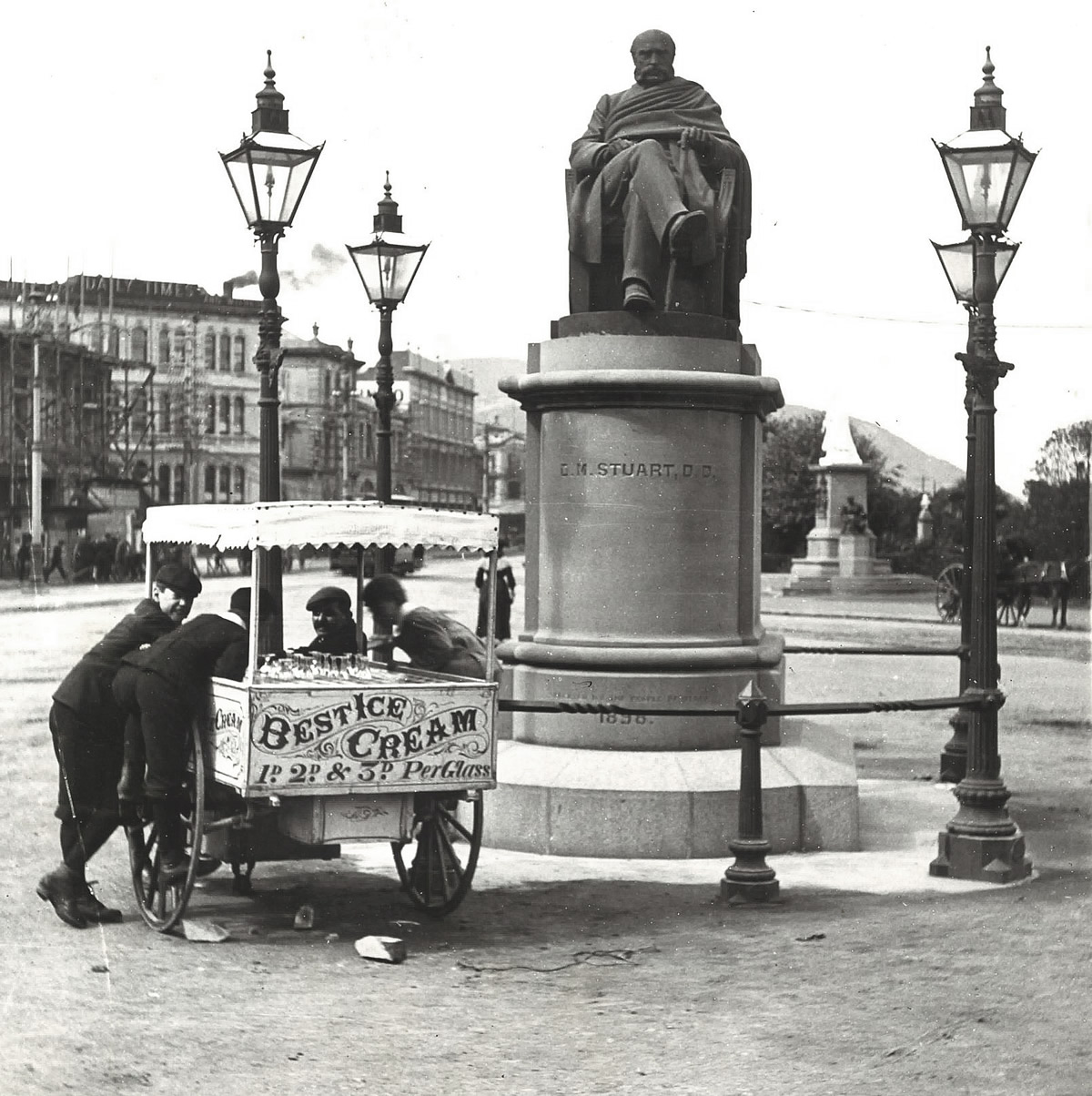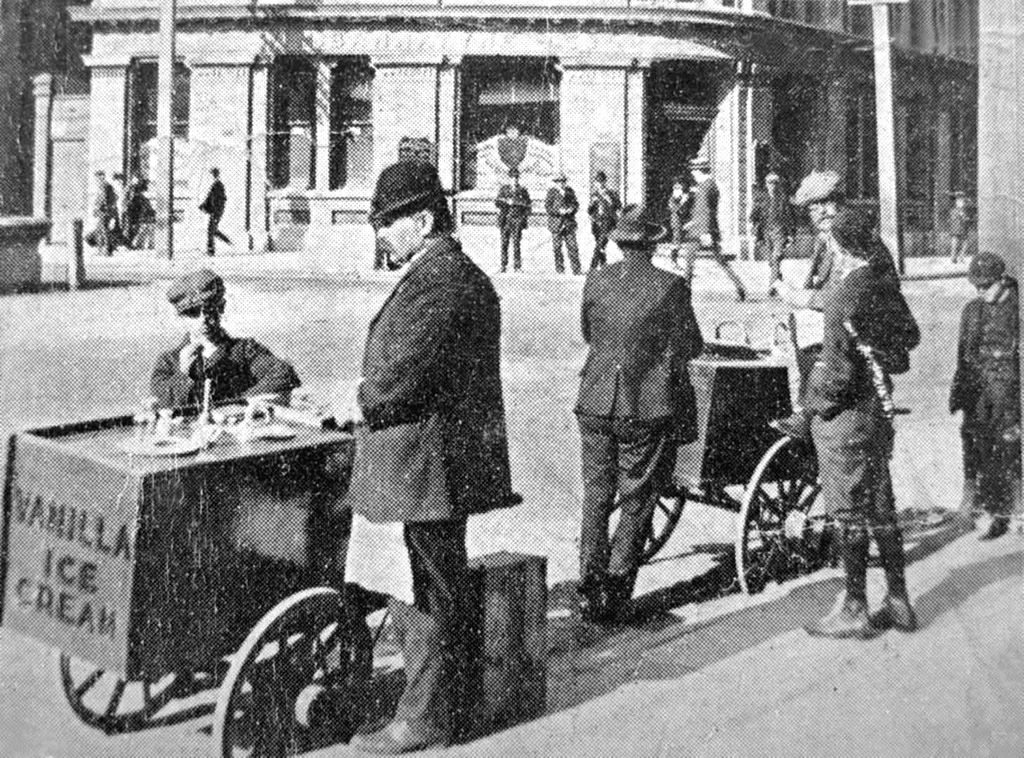Sali Mahomet became a Christchurch city
institution and continued to sell ice cream in the Square until 1942.
Newspapers of the day record applications for licenses to sell ice cream
from several individuals, debates over the virtues (or otherwise) of
the various applicants, prosecutions and discussions of their nuisance
value in impeding roads and footpaths around the cenral City. Others
included Abdul Boreham, Soloman Shah and
fellow ‘Assyrian’ Charles Abraham.
It seems Christchurch had a long tradition of ice cream vendors, including
a Mrs McKeown of Sydenham and Oxford Terrace, and Archie,
who for many years had an elaborate barrow complete with awning near
the old Clock Tower in Litchfield St. Archie's Deluxe Special sold
for threepence - vanilla ice, raspberry jelly and fresh cream, served
on a glass dish.

Ice cream vendor, Queen's Gardens, Dunedin,
1906
- Hocken Collections, Hardwicke Knight papers.
Ref: MS-4171/0397.

Ice cream vendor, corner Customhouse Quay and Grey St., Wellington,
ca. 1910
- Darian Zam.
References can be found to ice cream vendors in Lyttelton (1909),
and at East End Beach, New Plymouth in 1910.

Horse-drawn ice cream cart, Wellington, ca. 1910
- Frostee Digest.
Newspapers also record an ice cream vendor who pushed his barrow around
Auckland in the early 1900's, timing his rounds to arrive at the front
gate of the Boys Grammar School in Symonds Street at lunch-time, and
seen selling door-to-door around College Hill.
The Problem With Sunday
It is ironic, given the general acceptance that the word "sundae" arose
from ice cream dishes originally designed to be eaten on a Sunday, that
ice cream sellers and manufacturers found this the most difficult day
of the week to do business.
Sundays were seen as days of rest, not commerce, and many held the opinion
that such frivolous activities as eating ice cream were a distraction
from more proper Sunday responsibilities.
In response to religious criticism of the consumption of "sinfully" rich
ice cream sodas on Sundays, American entrepreneurs took out the carbonated
water and invented the ice cream "Sunday" in the late 1890's.
The name was eventually changed to "sundae" to
remove any connection with the Sabbath.
At the turn of the century, the sale of ice cream was still officially
seen as a non-essential activity, and to sell ice cream on a Sunday was
in contravention of the Trading laws.
1908 - A Press Agency report appeared in several
newspapers on 1 March:
At the Auckland Police Court,
Louie Rosina, Michael McLaughlin, and George Rowe, all proprietors
of soft drink and ice cream establishments in Hobson-street,
were required to explain their contravention of the Shops and
Offices Act on Sunday, 16th inst., by having their premises open
for business.
Sergeant Eales was passing down the street about the time people
came out of church, when his attention was attracted by the issuing
from Rosina's shop door of children, all absorbed in the demolition
of ice cream wafers. Rosina's shop was visited by the sergeant, and
the owner warned, but a few minutes later the ice cream exodus was
going on again merrily. |
Each of the three shop owners was fined £1 and court costs.
By 1910, the laws appear to have been changed to allow
the sale of ice cream on Sundays, but only "for consumption on the
premises". In a letter to the Editor of the Manawatu Times,
on 29 November, a Mr W. J. Culver initiated a heated debate when he argued
that:
... most of the children who
spend their pennies on ice creams are given these pennies to
take to Sunday School and for use in the Services of God, therefore
if those pennies are devoted to any other use than the purpose
for which they are intended, they are as deliberately stolen
as if they were taken out of the till or from another person's
pocket.
... But the receiver is as bad, and in some cases worse than the
thief, and I have no hesitation whatever in saying that the Sunday
vendors of ice cream and lollies are the worst sinners of the two.
Not only are they receivers of stolen money but they encourage
the children to commit the theft and are responsible, I believe
in many
instances for a child beginning its downward career towards the
saddest of all ends - the gaol. |
New Zealand's restrictive Sunday trading laws continued to be a problem
for ice cream manufacturers well into the 1930s - it was illegal for
them to deliver ice cream on Sundays, and it was illegal for retailers
to sell ice cream on Sundays unless it was "consumed on the premises".
The Sunday Trading laws were not changed to permit the sale of ice cream
for consumption off the premises until 1955.
Early Manufacturing
Larger scale commercial production of ice cream involved freezers that
were essentially bigger versions of the original hand-cranked churns,
but with the mechanical effort required provided by either steam, or
increasingly, electricity.
|